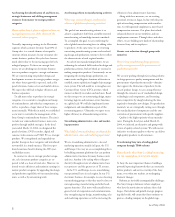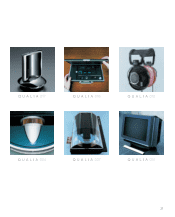Sony 2004 Annual Report Download - page 19
Download and view the complete annual report
Please find page 19 of the 2004 Sony annual report below. You can navigate through the pages in the report by either clicking on the pages listed below, or by using the keyword search tool below to find specific information within the annual report.
17
Capture it on DVD and watch it on a DVD player
The first-generation consumer DVD based video
camera, DVD Handycam, was a huge hit in the U.S.
In developing the next generation of models,
further miniaturization is the key
Sony’s video camera, DVD Handycam, was a
major hit in the U.S. market during the fiscal year
ended March 31, 2004. As the name suggests,
unlike other conventional video cameras, DVD
Handycam uses a DVD as its storage medium.
Material recorded on the DVD can be viewed
right away on a DVD player at home or can be
copied to another DVD for friends and family. Its
light weight, in particular, has made it very popu-
lar among many users, especially among families
who want to capture memories of their children
growing up or family vacations.
Sony’s next goal was to make an even smaller
DVD Handycam so that even more people could
enjoy this technology, and a project team was
established with this aim in mind. Smaller size
naturally requires both smaller components and
lower power consumption. While smaller compo-
nents reduce the overall size, the circuitry would
overheat if the same level of power were to be
used. Sony engineers solved this problem by
adopting the Intermittent Recording Method, a
technique that is not possible with a videotape.
Normally, when recording to a DVD, the data of
the moving image is simultaneously saved in the
memory and written onto the disc by laser, and it
is this part of the process that consumes the most
energy. Using the Intermittent Recording Method,
disc recording is twice as fast as normal speed,
meaning that recording takes half the time,
thereby lowering power consumption. This inno-
vative approach has facilitated a level of energy
efficiency that eliminates the risk of overheating
and has enabled this second-generation DVD
Handycam to be 30% smaller in size than the
first-generation model.
Taking advantage of features unique to DVDs
One of the biggest challenges in using a DVD
rather than a videotape for this video camera was
the problem of vibration. A shock or jolt can
interrupt the recording process on a DVD, in the
same way that a bump can cause the needle of a
record player to jump. To solve this problem, Sony
engineers applied their broad knowledge of drive
mechanisms, software and electronic circuit
technology to create a mechanism that is capable
of precisely offsetting the force of an external
shock. However, there are many other types of
vibrations and jolts that the video camera must be
able to cope with. During a testing phase that
was nicknamed the “Vibration Project” by those
involved, Sony conducted repeated and rigorous
testing on nearly 100 types of vibration and
impact right up until the start of mass production.
Engineers also focused on achieving an image
with the highest possible resolution by utilizing
Variable Bit Rate (VBR) Recording. With this tech-
nique, a fast-moving scene is recorded at a higher
bit rate, while a slower bit rate is used to record
scenes with less movement. Because bit rate
adjusts according to the volume of visual data,
the capacity of the DVD is more efficiently utilized
and picture quality is significantly enhanced.
Another advantage of this technique is that there
is less digital noise compared to Constant Bit Rate
(CBR) Recording, thereby making it possible to
record a wide range of subjects with the same
consistently high-quality picture.
For the next generation of DVD Handycam,
Sony engineers are working hard to pull a few
more exciting surprises out of the hat for video
camera users around the world.
Tadayuki Miyamoto
Project Leader
Design 2 Section 2 Group
Camcorder Business Section
Personal Video Company
IT & Mobile Solutions Network
Company
Yukiko Sakota
Planning Group
Personal Video Product Planning
Section
Personal Video Company
IT & Mobile Solutions Network
Company
There is no danger of mistakenly
recording over other material
DVD Handycam uses a DVD with a diameter of
8cm. It automatically records new material onto
unused disc space, so there is no need to fast
forward or rewind, or worry about mistakenly
recording over other material.
DVD editing is easy
By using a DVD-RW disc in Video Recording
(VR) mode, DVD Handycam functions as a
simplified editing tool. Users can easily erase
unwanted scenes, split and rearrange scenes,
and perform other basic editing functions.
It has never been easier to dub
content and send it to family
and friends
Material stored on DVD Handycam can
be dubbed for family and friends by
using either a DVD recorder with a hard
disk or a PC.
I want to be able to find any
scene I want quickly
With DVD Handycam’s Visual Index
function, the content on the disc can be
checked at a glance. To play a specific
scene, simply select it from the on-
screen display.
Masahiro Shigenobu
Project Manager
Media Technology 3 Group
Camcorder Business Section
Personal Video Company
IT & Mobile Solutions
Network Company
Rewritable DVD
Example of a Visual Index
File 06: Video Camera “DVD Handycam”
[DCR-DVD201]
http://www.sony.net/Products/handycam/
























